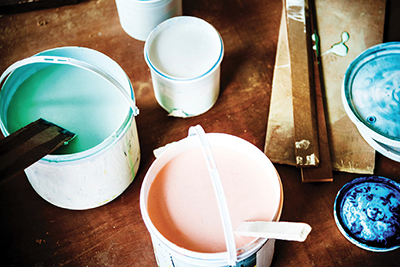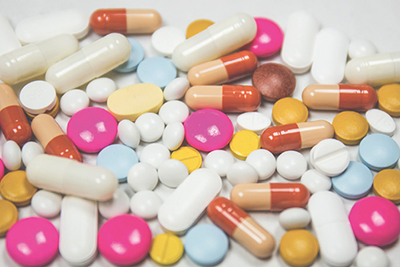Guide G-312
Revised by Sonja Koukel and Rick Griffiths
College of Agricultural, Consumer and Environmental Sciences, New Mexico State University
Authors: Respectively, Community and Environmental Health Specialist, Department of Extension Family and Consumer Sciences; and Extension Family and Consumer Sciences Agent, San Juan County Extension Office, New Mexico State University. (Print friendly PDF)
Introduction
Household chemical products can be extremely dangerous. When used incorrectly, they can create poisonous gases that can cause severe health problems. Additionally, many household chemicals include corrosive materials that can cause property damage and serious bodily injury when not handled properly. A corrosive material is one that will destroy and damage other substances it comes into contact with.
Some household chemicals are flammable. When not handled properly, these chemicals can cause fires or explosions. Because of these dangers, it is critical that household chemicals be used safely. Further, they must be disposed of safely to avoid harming people or the environment.
Household chemicals can sometimes be referred to as “household hazardous waste.” These chemicals are safe when used according to the directions on the label provided by the manufacturer. However, whether stated in the manufacturer’s directions or not, it is wise to wear gloves and eye protection when using household chemicals.
Hazardous chemical waste products can include acids, paints, poisons, and solvents. When buying these products, you should purchase only what you need and reuse as much as possible. Use non-hazardous alternative products and materials when possible (New York State Department of Environmental Conservation [NYSDEC], n.d.). For more information on how to make your own non-hazardous cleaning products, see NMSU Extension Guide G-313, Green Alternatives to Toxic Household Products and Hazardous Waste (https://pubs.nmsu.edu/_g/G313.pdf).
NEVER dispose of hazardous wastes down the sink drain or the toilet because this can pollute drinking water. Additionally, do not dump any household chemicals on the ground. Chemicals may flow into surface waters and eventually into groundwater sources where, again, they can pollute drinking water. Do not burn waste products since they can release toxic fumes or gases into the air.
The best way to safely dispose of household chemicals is to follow the manufacturer’s recommendations. Some household chemicals need to be taken to local hazardous waste management sites. Check with your local environmental health department, solid waste agency, or fire department for information on disposal options in your area. What follows are suggested guidelines for disposing of household chemicals safely.

© rawpixel | Unspalsh.com
Table 1 lists important information to follow when using household chemicals. Take time to read it and display it in a prominent area in your home. Be sure to fill in the telephone numbers of your medical care provider and fire department.
- Acids and bases. Acids are found in cleaning products such as toilet bowl cleaners, drain cleaners, and swimming pool chemicals. The product ingredient label usually contains the word “acid.”
Bases are corrosives. They can be found in bleaches, oven cleaners, drain cleaners, and disinfectants. The ingredients list may have such terms as lye, hydroxide, and hypochlorite.
The best way to dispose of acids and bases is to use the entire product. If you do have leftover chemicals you will not use or cannot give to someone else, save them for a household hazardous waste collection program. Check with your local environmental, health, or solid waste agency for information on household hazardous waste management options in your area. - Aerosols. Empty aerosol containers can be dangerous because the containers may explode under heat or pressure. Completely empty the container before discarding it with other household trash. Check with your local recycler to see if aerosol cans are eligible for recycling in your area.
If the product is not hazardous, empty the container by spraying it outdoors into an empty box or paper bag. Allow the contents to dry completely before discarding along with household trash.
If the product is hazardous, store it until a household hazardous waste collection program is available in your area (NYSDEC, n.d.). - Antifreeze. Store out of reach of animals and children. They are attracted to the sweet taste of the antifreeze. Do not pour used antifreeze down the drain or on the ground. Take any used or unused antifreeze needing disposal to a local hazardous waste management site.
Antifreeze can be recycled. Check with a local garage, public works department, or motor vehicle salvage yard to see if you can recycle your antifreeze with theirs (NYSDEC, n.d.). - Bleach. Try to use all the product. NEVER mix chlorine bleach with ammonia or acidic products, such as drain cleaners, toilet bowl cleaners, or metal cleaners, because it will release toxic fumes strong enough to be fatal. Any leftover bleach can be flushed down the toilet or washed down a drain followed with plenty of water.
- Cleaners and polishes. Cleaners and polishes (rug cleaner and floor and furniture polish) should be used completely whenever possible. Check the manufacturer’s directions for proper disposal. Unless instructed otherwise, seal empty containers and dispose of them with the rest of your household garbage (Ohio Environmental Protection Agency, 2010).
Oven cleaners:
- Small amounts of oven cleaners made without sodium hydroxide or lye can be flushed down kitchen drains or toilets with plenty of water.
- Cleaners containing sodium hydroxide or lye should be disposed of through a household hazardous waste collection program.
If a product is normally flushed down the drain during use, as most cleaners and detergents are, the product can usually be disposed of by pouring it down the drain slowly with running water. Never pour metal polishes, wood polishes, waxes, and other solvent-based cleaners down the drain. Instead, store them until you can dispose of them with a household hazardous waste collection program.
- Disinfectants. Most of these products contain strong chemicals. Use the products completely according to label instructions and with caution. Disinfectants containing ortho-phthalaldehyde (OPA) are not classified as environmentally hazardous. OPA solutions can be poured down the drain with plenty of cold running water. When in doubt of the ingredients, store for a household hazardous waste collection program (University of Rochester, 2016).
- Gasoline. Avoid buying more than you can use in six months. Store in a cool, dry place. Gas that is less than one year old can be safely used as fuel in your car, lawnmower, leaf blower, or snow blower. Strain the gas through a paint filter and mix it with at least an equal amount of fresh gasoline.
Gasoline is a hazardous material and needs to be disposed of properly. Never dispose of gasoline by pouring it onto the ground or into a sewer, street drain, stream, or other body of water, or putting it into the trash. Find the nearest disposal center for old or contaminated gasoline:
- Search online for “hazardous waste disposal center” in your area.
- Call the county or city waste management agency and ask where gasoline can be disposed of.
- Paint. If possible, use the product completely. If you can’t use it all, give it to someone who can. Schools and community groups may take donations of paint.
There are two general categories of paint: water-based latex and oil-based/alkyd paint.
- Water-based latex: These paints are not considered hazardous household wastes. Allow the paint to dry out and harden. If allowed in your area, the paint can be thrown out with household trash (True Value Paint, 2017).
- Oil-based/alkyd paint: Store these paints for a household hazardous waste collection program (NYSDEC, n.d.).
- Pesticides (including insecticides and herbicides). These products are chemicals created to kill unwanted insects, animals, plants, or microorganisms. They can be toxic to humans or pets.
Use pesticides completely according to label directions. Unused products should be stored for a household hazardous waste collection program.
Rinse empty containers three times before throwing them away. The rinse water should be saved and used as a pesticide. The empty container should then be wrapped in newspaper and discarded with household trash (NYSDEC, n.d.). For more information, see NMSU Extension Guide G-311, Safe Disposal of Household-Use Pesticide Containers (https://pubs.nmsu.edu/_g/G311.pdf). - Solvents. Solvents include degreasers, paint thinners and strippers, spot removers, turpentine, and varnish. Used solvents can be cleaned by allowing the paint or dirt particles to settle out in a container. Pour the cleared solvent into another container to use again. Discard the sludge that has settled at the bottom of the container in the trash. Do not dump the sludge onto soil or down sewers, drains, or the toilet. Large amounts of sludge (more than 10 gallons) should be taken to a recycler or local household hazardous waste management site.
|
Table 1. Using Household Chemical Products Safely |
|
|
Do |
Don’t |
|
Always read labels before buying a product to be sure it will meet your needs. |
Don’t remove product labels. |
|
Buy only what you need. Whenever possible, reduce the number of products you buy. Many times a general-purpose household cleaner can be used instead of cleaners designed for a specific purpose. |
Don’t remove products from their original containers for storage or future use. |
|
Read and follow directions carefully. Always use products in the recommended concentration. |
Don’t mix household chemicals or wastes together. |
|
Know which products are toxic and store them accordingly. |
Don’t store household chemicals within the reach of children. |
|
Teach children the dangers of poison. |
Don’t store household chemicals on shelves normally used for foods. |
|
Keep hazardous substances out of the reach of children and pets. Use child-resistant caps. Replace child-resistant caps securely after using the product. |
Don’t store hazardous substances in containers that are generally recognized as food containers. |
|
Empty all aerosol cans (of non-hazardous products) by depressing the button until no more product comes out. |
Don’t dispose of hazardous substances by pouring onto the ground, down the drain, or down the sewer. |
|
Wrap containers in newspaper before placing them in the trash if the label contains a warning about not getting the contents on your skin. |
Don’t store incompatible products together. Flammables should never be stored with corrosives. Poisons should always be kept separate. |
|
Contact the product manufacturer if you have any questions regarding the proper use, storage, or disposal of the product. |
Don’t bury containers of leftover hazardous substances. |
|
Don’t burn plastics, paint, insulation, or other potentially hazardous materials that might produce toxic fumes. |
|
|
Don’t dump hazardous wastes by the side of the road. |
|
Emergency Phone Numbers
The New Mexico Poison and Drug Information Center: 1-800-222-1222
Emergency: 911
Fire: ________________________________
Doctor: ______________________________

Dispose of Medicines Properly (EPA, 2011)
DO NOT: Flush expired or unwanted prescription, non-prescription, and over-the-counter drugs down the toilet or drain.
- In homes that use septic tanks, drugs flushed down the toilet can leach into the ground and seep into groundwater.
- When residences are connected to wastewater treatment plants, drugs poured down the sink or flushed down the toilet can pass through the treatment system and enter rivers and lakes. Water treatment plants are generally not equipped to routinely remove medicines.
DO: Return unwanted or expired prescription, non-prescription, and over-the-counter drugs to a drug take-back program. Call your city or county government’s household trash and recycling service. Ask if a drug take-back program is available in your community. Or, follow these steps for household disposal:
- Take your prescription drugs out of the original containers.
- Mix drugs with an undesirable substance, such as cat litter or used coffee grounds.
- Put this mixture into a disposable container with a lid, such as an empty margarine tub, or into a sealable bag.
- On the empty containers, conceal or remove any personal information, including the prescription (Rx) number, by covering it with permanent marker or duct tape, or by scratching it off.
- Place the sealed container with the drug mixture, and the empty drug containers, in the trash.
Resources
Environmental Protection Agency (EPA). 2011, April. How to dispose of medicines properly [Online]. https://www.epa.gov/sites/production/files/2015-06/documents/how-to-dispose-medicines.pdf
Griffiths, R., and S. Koukel. 2019. Green alternatives to toxic household products and hazardous waste [Online]. New Mexico State University Cooperative Extension. https://aces.nmsu.edu/pubs/_g/G313.pdf
New York State Department of Environmental Conservation. n.d. Managing and disposing of household hazardous waste [Online]. https://www.dec.ny.gov/docs/materials_minerals_pdf/hhwma.pdf
Ohio Environmental Protection Agency. 2010, May. A guide to safe management of household hazardous waste [Online]. https://www.fairfield-city.org/DocumentCenter/View/735/Guide-to-Safe-Management-of-Household-Hazardous-Waste-PDF?bidId=
True Value Paint. 2017. How to dispose of old paint [Online]. https://www.truevaluepaint.com/paint/interior/prep_cleanup_and_safety/leftover-paint-disposal.aspx
University of Rochester Environmental Health & Safety, Occupational Safety Unit. 2016, November 16. Disposal protocol for high level disinfectants (HLDs) [Online]. https://www.safety.rochester.edu/ih/disinfectants/disposalprotocol.html
For further reading
G-311: Safe Disposal of Household-Use Pesticide Containers
https://pubs.nmsu.edu/_g/G311/
G-313: Green Alternatives to Toxic Household Products and Hazardous Waste
https://pubs.nmsu.edu/_g/G313/
G-315: Green Cleaning Methods for Your Home
https://pubs.nmsu.edu/_g/G315/

Sonja Koukel is Assistant Professor and Extension Community and Environmental Health Specialist in the Department of Extension Family and Consumer Sciences. She earned her B.S. at NMSU and her M.S. and Ph.D. at Texas Tech University. Her Extension programs focus on health and wellness—physical, mental, spiritual, and environmental.
To find more resources for your business, home, or family, visit the College of Agricultural, Consumer and Environmental Sciences on the World Wide Web at pubs.nmsu.edu.
Contents of publications may be freely reproduced, with an appropriate citation, for educational purposes. All other rights reserved. For permission to use publications for other purposes, contact pubs@nmsu.edu or the authors listed on the publication.
New Mexico State University is an equal opportunity/affirmative action employer and educator. NMSU and the U.S. Department of Agriculture cooperating.
Revised February 2019


